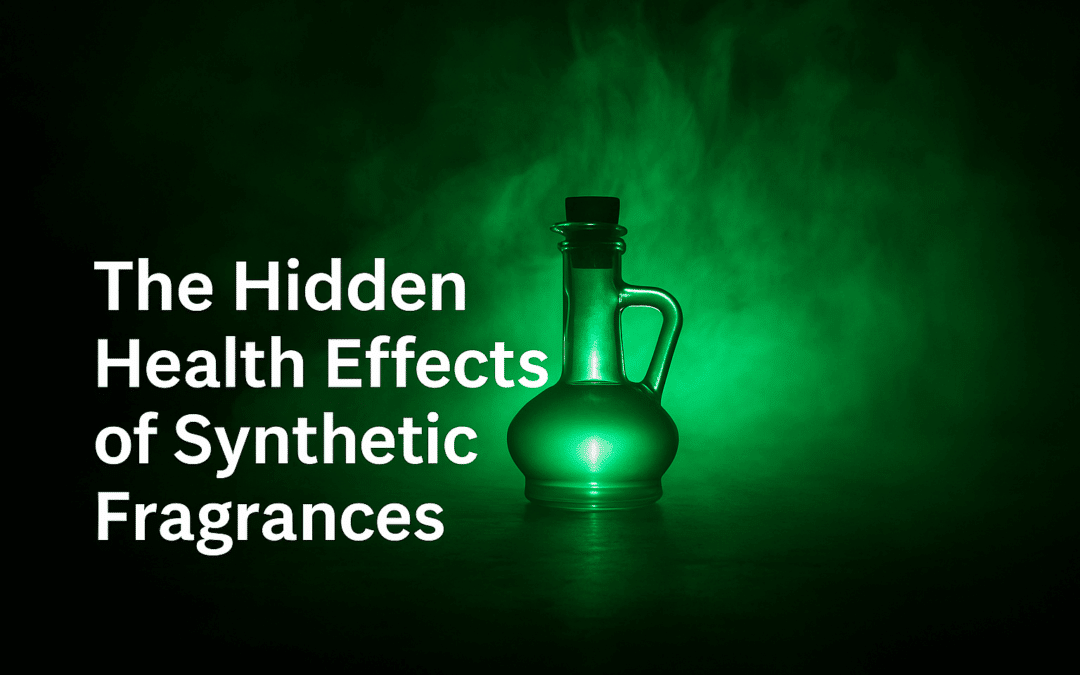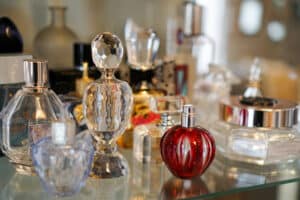The Hidden Health Effects of Synthetic Fragrances
Most people associate perfume with elegance, confidence, or self-expression. Yet few realize that the pleasant aroma lingering in the air might also come with invisible consequences. Modern life is drenched in scent—detergents, lotions, candles, and personal sprays—all infused with complex chemical blends. Understanding these synthetic fragrance health effects is an important step toward protecting long-term wellness and slowing the aging process.
These synthetic fragrance health effects accumulate over time, affecting everything from hormone balance to energy levels. Walk down any supermarket aisle, and you’ll be surrounded by “ocean breeze,” “fresh linen,” or “tropical escape.” But behind those comforting labels often hides a stew of industrial compounds that your body must filter out—compounds that quietly add to your toxic load day after day.
Perfume’s Hidden Source: The Petrochemical Connection
Perfume is often marketed as a luxury art form, but its ingredients are far from natural. Most mainstream brands use synthetic aromatic compounds derived from petroleum, the same source used in fuel and plastic manufacturing. These chemicals can be produced at extremely low cost yet sold in bottles costing hundreds of dollars.
What’s more, manufacturers aren’t required to list every component. The word “fragrance” on a label can legally conceal hundreds of unlisted ingredients. According to the Environmental Working Group (EWG), many of these hidden substances are linked to allergies, hormone disruption, and oxidative stress. Research from the National Institutes of Health confirms that several act as endocrine disruptors—interfering with normal hormonal balance.
Common offenders include:
- Phthalates – help scent last longer but interfere with hormone function.
- Musk ketones – persist in the environment and accumulate in human tissue.
- Benzene derivatives and aldehydes – irritate skin and cause headaches or dizziness.
- Toluene – a solvent associated with liver and kidney toxicity.
Every spritz, dab, or whiff introduces these compounds into your system. The body must metabolize them as it would any other chemical exposure. That’s where the connection between synthetic fragrance health effects and overall well-being becomes personal.
Absorbing What You Wear and Breathe
Your skin is more than a barrier—it’s a portal. Anything applied topically, from lotion to perfume, can penetrate the surface and enter the bloodstream. Inhalation exposure is equally potent. When you breathe in scented air, microscopic particles reach the lungs, circulate through the body, and must be processed by detox organs such as the liver and kidneys.
This continual skin and inhalation contact illustrates the daily synthetic fragrance health effects most people overlook. The lotion on your arms, the shampoo in your hair, and the detergent on your clothes can all become silent chemical contributors—each small dose adding to a cumulative toxic burden.
How Synthetic Fragrances Accelerate Aging
Your body’s detox systems are designed to handle natural exposures, but not the constant stream of artificial chemicals in modern life. When the toxic load becomes excessive, the result is inflammation, oxidative stress, and impaired cellular repair—all direct accelerators of premature aging.
The oxidative stress behind these synthetic fragrance health effects also accelerates collagen breakdown and visible aging. Prolonged exposure to synthetic fragrance chemicals has been linked with:
- Hormonal imbalance and thyroid disruption
- Fatigue, poor concentration, and brain fog
- Skin irritation, breakouts, and faster wrinkling
- Respiratory irritation or asthma
- Headaches and migraines
- Increased oxidative stress and DNA damage
If you’re committed to living longer, stronger, and clearer-minded, lowering your fragrance exposure is one of the easiest anti-aging strategies you can adopt.
Fragrance Pollution in Everyday Life
The challenge isn’t limited to perfume counters. Today, synthetic scents saturate nearly every household item:
- Shampoos, conditioners, and deodorants
- Body lotions and cosmetics
- Candles, air fresheners, and diffusers
- Laundry detergents and dryer sheets
- Cleaning sprays and surface wipes
These volatile organic compounds (VOCs) drift through indoor air, cling to fabrics, and form new pollutants as they mix with other chemicals. In enclosed environments, this creates a background haze of low-grade toxicity that your body constantly has to handle.
Indoor air studies show that synthetic fragrance health effects extend beyond perfume to nearly every scented product. Ever notice how one heavily scented person can “fill the room”? That’s by design—those molecules are engineered to linger, spread, and stick.
A Personal Lesson in “Freshness” Overload
Years ago, my wife and I stayed in a guest house that redefined the word “fragrant.” Within seconds of walking in, our eyes watered, and a dull headache set in. After some detective work, I discovered plug-in air fresheners scattered everywhere—eight, maybe ten of them. Even open windows couldn’t clear the chemical fog.
That night underscored what “fresh scent” can really mean: volatile compounds saturating the air, irritating the lungs, and overloading the liver’s detox capacity. Experiences like that remind me that “pleasant smell” isn’t always synonymous with health.
Misleading Labels: “Natural,” “Unscented,” and “Fragrance-Free”
Marketing often plays tricks on the well-intentioned consumer.
- “Fragrance-free” products sometimes use masking agents to hide odors.
- “Natural” items may still contain synthetic fragrance components mixed with essential oils.
To minimize exposure:
- Choose goods labeled “no synthetic fragrance”.
- Opt for essential-oil-only scents and verify purity certifications.
- Use unscented detergents and cleaning supplies verified by EWG or Made Safe.
- Replace air fresheners with natural alternatives—open windows, beeswax candles, or houseplants.
Natural Scents and Clean-Air Living
Eliminating artificial fragrance doesn’t mean giving up pleasant aromas. Natural scents—lavender, citrus, mint, or eucalyptus—can uplift mood when used responsibly. Diffuse essential oils in moderation and prioritize ventilation. The aim isn’t to erase all scent, but to remove chemical overload so the body can focus on healing, regeneration, and balance.
By reducing synthetic fragrance health effects, you lighten the load on your liver and skin, which can translate into better energy, improved immunity, and a more youthful appearance.
Smell Younger, Live Longer
Anti-aging isn’t only about creams or supplements—it’s about what you keep out of your system. Reducing synthetic chemical exposure helps your cells repair efficiently and maintain resilience against oxidative stress.
Understanding and minimizing synthetic fragrance health effects is one of the simplest anti-aging habits you can adopt. If you’re committed to a cleaner lifestyle that supports longevity from the inside out, explore our curated collection of wellness products designed to help the body detoxify naturally. Visit BIOptimizers at AntiAgingForYou for supplement support that enhances digestion, liver health, and overall vitality.
The Takeaway
Your favorite fragrance might lift your mood—but it can also weigh down your health. Every drop contains a chemical signature your body must process. The science on synthetic fragrance health effects is clear: less exposure means fewer free radicals, better hormone balance, and a cleaner path to graceful aging. If you wouldn’t eat it, think twice before wearing it.
Frequently Asked Questions
How do synthetic fragrances accelerate aging?
Many contain petrochemical derivatives that act as endocrine disruptors or generate oxidative stress. This increases free radicals and weakens collagen repair—both linked to premature aging and cellular decline.
How can I support detox pathways after fragrance exposure?
Hydration, sauna therapy, magnesium, and targeted supplements that enhance liver function—such as those offered by BIOptimizers—help your body process and eliminate toxins more efficiently.




